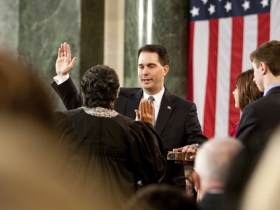More Jobs, Less Pay
Wisconsin sees the largest month-to-month gain in a decade but most are low-wage jobs.

Gov. Scott Walker
The good news: Wisconsin had a June jobs surge, a boost from May of 13,800 private sector jobs. State officials rightfully called it the largest month-to-month gain in nearly a decade.
The bad news: Most of the growth—7,200 jobs—was in the “leisure and hospitality” sector, where average weekly pay was only $284 last year. That’s barely one-third the overall average wage in Wisconsin of $803.
What it means: The administration says the numbers “point to a trajectory of economic growth in Wisconsin under Governor Walker’s leadership,” according to the Secretary of the Department of Workforce Development.
But much closer to the mark is the perspective of the state’s bankers. “The economy seems to have reached a plateau,” said the president of the Wisconsin Bankers Association, the day before the jobs numbers came out. “The state economy [is] flat.”
The June jobs report should also be taken with a good deal of caution, as monthly reports by the U.S. Bureau of Labor Statistics are based on a small sample and can be off by more than 9,000 jobs in either direction in any given month for a state like Wisconsin. Leisure and hospitality jobs, moreover, can often be short-term summer jobs, although the data are corrected for seasonal swings.
If June 2013 is compared with June 2012—a year-to-year comparison rather than month-to-month—we ranked 38th among the states in job growth.
Conclusion: The news is mixed at best because most of the growth was in the lowest paid sector of the economy. The Milwaukee Journal Sentinel quoted an economist saying, “Low-quality jobs are better than no jobs.” That may be true for the Walker administration’s boasts, but it’s a terrible way to grow an economy.




















There are two funny things related to this.
1. The same righties who will cling to this saying “see, it’s working” are the same dopes who claimed that June’s strong US jobs report was meaningless behind many of the jobs added were in low-wage, seasonal industries. So do we credit both Obama and Walker, or think that this report indicates next to nothing for long-term growth?
2. Wisconsin had the exact same thing happen 2 years ago, where there was a “major increase” in jobs in June 2011 in the same sectors. At that time, Walker held a huge press conference taking credit for the good numbers, despite the fact that Walker’s own DWD said the increase was “questionable” because of the tourist-related nature of the job, with most of the increase being outside of Wisconsin metro areas. At least this time Walker’s Admin had the sense not to hold a big event with this release, probably cause they know this isn’t significant in the big picture.
With that in mind, watch for next week’s local and metro-area jobs numbers, which’ll tell you where these June jobs actually were created.
Most jobs being created in this country are low laying jobs, not just Wisconsin.
You need at least one producing type job to support two service sector jobs. Production type jobs could be manufacturing, trucking, government, utility, military, food processing, trucking, banking – jobs that provide incoming money to the local and regional economy. Service sector jobs tend to be lower paying and reside in areas like retail, restaurants, health care, various services like sewer, water, trash pickup and disposal, legal, home construction and remodeling, etc. There may be crossover in some areas depending on the company cash flow in our out of a region. The service sector cannot flourish without production jobs that bring in outside cash flow and the ability of a community to hold onto funds to re-churn in its own marketplace.
D said: “Most jobs being created in this country are low laying jobs, not just Wisconsin.”
Since January of 2011, about 1/3 (32%) of Wisconsin private sector jobs created have been in leisure and hospitality. Nationally, the equivalent figure is about 1/5 (21%).
Thus, even taken over a longer period, Norman’s basic point is sound.
And since there are not enough production jobs being created in Wisconsin and across the US, we are onto a pathway of continued stagnation and contraction. The Great Middle Class was created after WWII when the USA held 60% of the world market place with most of the competition being eliminated. So the Middle Class family saw a peak earning and purchasing year during 1968-69 and has been on the decline ever since. The USA is now at about 18% of the world market and on the decline. China is at 18% and on the increase.